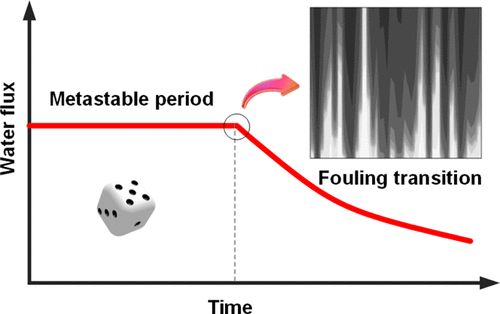当前位置:
X-MOL 学术
›
Environ. Sci. Technol.
›
论文详情
Our official English website, www.x-mol.net, welcomes your feedback! (Note: you will need to create a separate account there.)
Stochastic Collision-Attachment-Based Monte Carlo Simulation of Colloidal Fouling: Transition from Foulant-Clean-Membrane Interaction to Foulant-Fouled-Membrane Interaction.
Environmental Science & Technology ( IF 11.4 ) Pub Date : 2020-09-02 , DOI: 10.1021/acs.est.0c04165 Junxia Liu 1 , Tianyi Huang 1 , Ruibo Ji 1 , Zhihong Wang 1 , Chuyang Y Tang 2 , James O Leckie 3
Environmental Science & Technology ( IF 11.4 ) Pub Date : 2020-09-02 , DOI: 10.1021/acs.est.0c04165 Junxia Liu 1 , Tianyi Huang 1 , Ruibo Ji 1 , Zhihong Wang 1 , Chuyang Y Tang 2 , James O Leckie 3
Affiliation

|
The initial behavior of colloidal fouling is governed by foulant–clean-membrane interaction (F–M), and its long-term behavior is determined by foulant–fouled-membrane interaction (F–F). Nevertheless, the transitional fouling behavior from F–M to F–F has not been fully understood. This study reports a novel collision attachment (CA)–Monte Carlo (MC) approach, with the stochastic colloid–membrane collision events modeled by MC and the probability of colloidal attachment to the membrane determined by the interplay of flux and the energy barrier arising from colloid–membrane interaction (Em for F–M and Ef for F–F). The long-term membrane flux remains stable for large Ef, whereas severe fouling occurs when both Em and Ef are small. Our study reveals the existence of a metastable flux behavior for the combination of large Em but small Ef. The time evolution of flux behavior and colloidal deposition patterns shows a nearly constant flux for an extended period, with the high energy barrier Em retarding initial colloidal deposition. However, accidental random deposition of a colloidal particle could reduce the local energy barrier (toward the smaller Ef), seeding for further colloidal deposition in its vicinity. This initiates an uneven patch-wise fouling and eventually leads to a complete transition to F–F-dominated behavior. The metastable period can be effectively extended by increasing the energy barrier (Em or Ef) or lowering flux, which provides important implications to membrane design and operation.
中文翻译:

基于随机碰撞附着的胶体污垢的蒙特卡洛模拟:从污垢-清洁-膜相互作用到污垢-膜污染的相互作用。
胶体污垢的初始行为由污垢-清洁膜相互作用(F-M)决定,其长期行为由污垢-污垢膜相互作用(F-F)决定。然而,从F-M到F-F的过渡结垢行为尚未得到充分了解。这项研究报告了一种新颖的碰撞附着(CA)-蒙特卡洛(MC)方法,其中随机胶体-膜碰撞事件由MC建模,胶体附着于膜的概率由通量和由产生的能垒相互作用决定胶体-膜相互作用(E m为F–M和E f为F–F)。对于较大的E f,长期的膜通量保持稳定,而当两个Em和E f小。我们的研究表明,大E m但小E f的组合存在亚稳态通量行为。助熔剂行为和胶体沉积模式的时间演化在延长的时间内显示出几乎恒定的通量,其中高能垒E m阻碍了初始胶体沉积。但是,胶体粒子的意外随机沉积会降低局部能垒(朝着较小的E f),播种以在其附近进一步胶体沉积。这会引发不均匀的逐块积垢,并最终导致完全过渡到F主导的行为。可以通过增加能垒(E m或E f)或降低通量来有效地延长亚稳期,这对膜的设计和操作具有重要意义。
更新日期:2020-10-06
中文翻译:

基于随机碰撞附着的胶体污垢的蒙特卡洛模拟:从污垢-清洁-膜相互作用到污垢-膜污染的相互作用。
胶体污垢的初始行为由污垢-清洁膜相互作用(F-M)决定,其长期行为由污垢-污垢膜相互作用(F-F)决定。然而,从F-M到F-F的过渡结垢行为尚未得到充分了解。这项研究报告了一种新颖的碰撞附着(CA)-蒙特卡洛(MC)方法,其中随机胶体-膜碰撞事件由MC建模,胶体附着于膜的概率由通量和由产生的能垒相互作用决定胶体-膜相互作用(E m为F–M和E f为F–F)。对于较大的E f,长期的膜通量保持稳定,而当两个Em和E f小。我们的研究表明,大E m但小E f的组合存在亚稳态通量行为。助熔剂行为和胶体沉积模式的时间演化在延长的时间内显示出几乎恒定的通量,其中高能垒E m阻碍了初始胶体沉积。但是,胶体粒子的意外随机沉积会降低局部能垒(朝着较小的E f),播种以在其附近进一步胶体沉积。这会引发不均匀的逐块积垢,并最终导致完全过渡到F主导的行为。可以通过增加能垒(E m或E f)或降低通量来有效地延长亚稳期,这对膜的设计和操作具有重要意义。



























 京公网安备 11010802027423号
京公网安备 11010802027423号